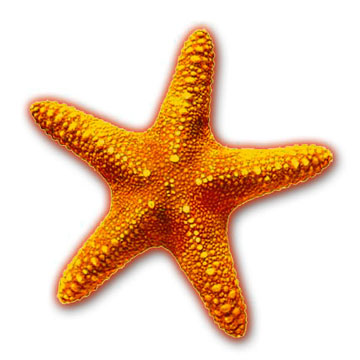
Starfish are carnivorous ocean animals that usually
have five starlike arms. They are related to
brittle stars, sea urchins, and sea cucumbers, all of
which are known as echinoderms. Like these animals,
starfish have spiny skins. Starfish make up
five orders-1,500 species-of marine invertebrates,
the class Asteroidea of the phylum Echinodermata.
They have radially arranged arms which
hold locomotor tube feet, and which reach diameters
from six inches to four feet. They are abundant
at all ocean depths and occur in all oceans except
near the North and South Poles. Often, a
starfish escapes its enemies by breaking off one or
more of its arms, which regenerates. In fact, if a
starfish is halved, quartered, or cut into smaller
pieces, each becomes a new individual.
The Physical Characteristics of
Starfish
Stiff-bodied, starfish move by
crawling slowly. Their bodies may
have five arms ormanymore. Starfish
skin is leathery and has protective
spines, which point upward.
The spines are made of lime
and develop from the skeleton.
The animal also has a large gut, a
complex system of body cavities,
and a nervous system but no brain.
The central body of a starfish is
located where its arms join. Its bottom
surface holds a mouth at the
point where all the arms meet. A
groove also stretches from the
mouth to each arm tip. There are
rows of holes in the grooves from
which tube feet can push out. The
feet, with sucker ends, enable crawling. They are
supported and moved by an internal hydraulic
system inflated with seawater.
Most of the central body is a baglike stomach
into which the mouth opens. Starfish also have
well-developed senses of touch, smell, and taste,
and respond to light. However, they lack the complex
behavior patterns of animals having brains.
The Life of the Starfish
Starfish spend much of their lives searching for
food, mainly clams, mussels, and oysters. To eat
bivalve mollusks, a starfish uses its tube feet to
open shell halves. It surrounds a mollusk, attaches
the tube feet, and uses them to pull in opposite directions.
Once the mollusk tires of resisting the
starfish's force, the shell opens. Then the starfish
pushes its stomach inside out through the mouth
and surrounds the mollusk body. Its stomach releases
digestive fluid and as the mollusk softens,
the starfish eats its flesh and releases the shell. A
similar technique is used with other foods, such as
coral. Coral polyps (individual corals) are eaten.
First, a starfish climbs onto a polyp and presses its
stomach out through its mouth. Then, digestive
juice softens the polyp's shell and turns the polyp
into a soupy liquid, which the starfish eats.
Starfish are themselves eaten by fish and snails.
Their most successful predators are giant carnivorous
sea snails, such as tritons. A triton rips starfish
open and eats their soft tissues. Fish also eat
starfish by flipping them over and biting off and
eating their soft centers.
Mating occurs in spring or summer, depending
on species and habitat. Most starfish have two
sexes and mate by secreting sperm and eggs into
the ocean (spawning). External fertilization follows
and the eggs become larvae. Larvae float in
the ocean and sink to its bottom to become adults.
Most starfish regenerate body parts. In some starfish,
this is also their mode of reproduction:Abud
grows and pinches off into a new starfish.
Three Sample Starfish Species
Sunflower starfish (Pycnopodia helianthodes), the
largest starfish, resemble sunflowers because of
their many arms. They grow to diameters up to
four feet and may have twenty-five arms. These
starfish inhabit the west coast of North America
from Alaska to California, from shallows to deep
water. They eat bivalves, sponges, coral, worms,
crustaceans, other starfish, and small fish. They
mate in spring, by spawning.
Crown-of-thorns starfish (Acanthaster planci)
are star-shaped with many body spikes (thorns).
They grow to two-foot diameters and have up to
twenty-four arms.Acrown-of-thorns starfish also
has a large, round midsection, which holds internal
organs and many tube feet. Crown-of-thorns
starfish inhabit tropical West Pacific and Indian
Oceans. Feeding on coral, they live on or near
coral reefs, such as Australia's Great Barrier Reef,
where they hide during the day and feed at night.
A single crown-of-thorns starfish can destroy 1.5
feet of coral reef per week.
European starfish (Asterias rubens) are fivearmed
starfish of the European and African
coasts. They grow to 1.5-foot diameters and have
tube feet. They feed on bivalves, sponges, corals,
worms, crustaceans, other starfish, and small fish.
They find food via chemical signals picked up by
tube feet. Their spring mating is by means of
spawning.
The main foods of starfish are mussels, oysters,
and clams. Starfish are thus serious pests on oyster
and clam farms. In addition, they eat coral and
can damage reefs. For example, crown-of-thorns
starfish sometimes overgrow and damage coral
reefs by eating too much coral.
Starfish Facts
Classification:
Kingdom: Animalia
Phylum: Echinodermata
Class: Asteroidea
Orders: Include Forcipulata, Forcipulatida, and
Spinulosida
Geographical location: All ocean depths in all
oceans, except near the North and South Poles
Habitat: Ocean bottoms, from shallow water to
great depths
Gestational period: No true gestation; sperms
and eggs are spawned into oceans, where the
eggs are fertilized; larvae drift, settle to the
ocean floor, and become adults
Life span: Not known
Special anatomy: Radially symmetrical arms, locomotor
tube feet, mouth and stomach cavity
that can turn inside out, protective spines
Other popular Animals
Photo Gallery of - Starfish








 Animalia Life
Animalia Life